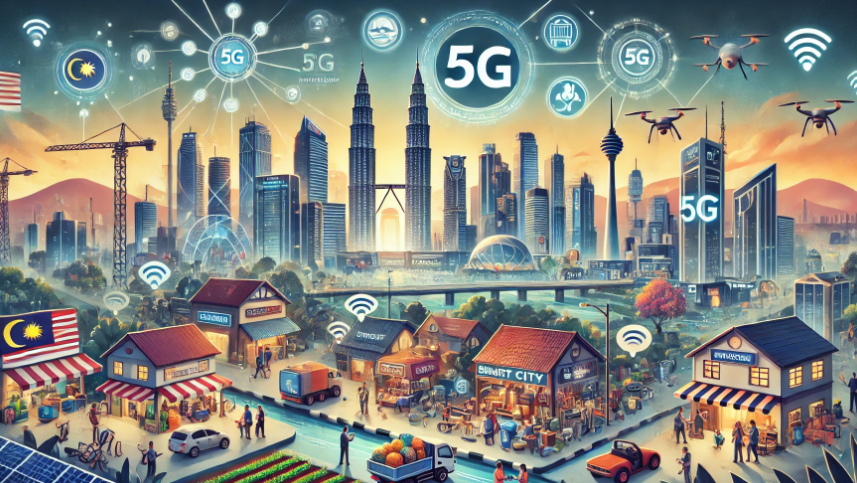Trident Blog
5G in Malaysia
Building a Sustainable Future
Importance of Financial Literacy
Inspiring Leadership
5G in Malaysia

The future of 5G in Malaysia promises significant advancements in connectivity and digital innovation across various sectors. As one of the leading Southeast Asian countries investing in 5G infrastructure, Malaysia aims to empower industries and communities with ultra-fast, low-latency internet, essential for the growth of smart cities, the Internet of Things (IoT), and Industry 4.0 applications. With the support of Digital Nasional Berhad (DNB), a state-owned agency responsible for deploying the 5G network nationwide, Malaysia envisions achieving widespread 5G coverage, enhancing its digital competitiveness and providing a robust foundation for advanced digital services in the economy.
Industries such as healthcare, manufacturing, and agriculture stand to benefit immensely from 5G’s rollout. For instance, 5G will enable remote healthcare services with real-time patient monitoring, which is crucial for rural areas where healthcare access is limited. In manufacturing, 5G’s low latency and reliable connectivity will support automation and remote operations, which can improve efficiency and reduce operational costs. Similarly, in agriculture, 5G technology can drive precision farming, allowing farmers to monitor crop health and optimize resource use with smart sensors and data analytics. This kind of connectivity can transform traditional sectors, creating new job opportunities and fostering innovation across industries.
However, to fully realize the potential of 5G, Malaysia must address certain challenges, such as regulatory hurdles, infrastructure costs, and cybersecurity. Collaborative efforts between the government, private sector, and international partners will be crucial to overcoming these barriers. By ensuring an inclusive 5G rollout, focusing on workforce training for new digital skills, and developing stringent data privacy measures, Malaysia can create a resilient 5G ecosystem that not only accelerates digital adoption but also safeguards citizens and businesses. Ultimately, Malaysia’s commitment to 5G will play a vital role in shaping a future-ready economy that supports sustainable growth and strengthens its position as a digital leader in the region.
Building a Sustainable Future
Sustainability is a holistic approach to meeting the needs of the present without compromising the ability of future generations to meet their own needs. It encompasses environmental, social, and economic dimensions, often referred to as the triple bottom line. At its core, sustainability emphasizes the responsible use of natural resources, reducing waste, and fostering practices that minimize environmental degradation. This philosophy has gained prominence as humanity grapples with challenges such as climate change, biodiversity loss, and resource scarcity. Additionally, it serves as a guiding framework for fostering resilience in communities and economies worldwide. By recognizing the interconnectedness of human actions, sustainability encourages collective efforts that can drive meaningful global change. It calls for a paradigm shift that values long-term gains and equitable outcomes over short-term profits and exploitation.

- Environmental sustainability focuses on preserving ecosystems, reducing carbon emissions, and adopting renewable energy sources. Practices such as recycling, sustainable farming, and water conservation play critical roles in this dimension. By protecting natural habitats and reducing reliance on fossil fuels, societies can mitigate the adverse effects of global warming and protect the planet’s delicate balance. Governments, businesses, and individuals alike have a shared responsibility to prioritize environmental stewardship.
- Social sustainability ensures that communities thrive by promoting equity, inclusion, and well-being. It involves addressing social issues such as poverty, education, and healthcare while fostering respect for cultural diversity and human rights. Initiatives like fair trade, ethical labor practices, and community development are integral to building societies where every individual has an opportunity to prosper. A socially sustainable world recognizes the interconnectedness of people and emphasizes mutual growth and respect.
- Economic sustainability, the third pillar, focuses on creating systems that are financially viable without exploiting people or the planet. This involves fostering innovation, supporting local economies, and transitioning to circular economies where resources are reused and regenerated. Businesses that adopt sustainable models often achieve long-term profitability by aligning with ethical practices and consumer demand for environmentally friendly products. Together, the three dimensions of sustainability work in harmony to ensure a balanced and resilient future for all.
Importance of Financial Literacy

Financial literacy is the ability to understand and effectively use financial skills, such as budgeting, investing, and managing money. In today’s complex economy, being financially literate is no longer a luxury but a necessity. It equips individuals with the knowledge and tools to make informed decisions that can significantly improve their financial well-being. Without financial literacy, even high-income earners can find themselves struggling with debt and financial instability.
A critical aspect of financial literacy is the balance between saving and spending. This is captured in the phrase, “Invest rightly, spend brightly.” This motto emphasizes the importance of making smart investment choices while also enjoying the fruits of one’s labor in a balanced and thoughtful way. It encourages individuals to focus on long-term financial growth through investments while still making room for meaningful, value-based expenditures.
To better understand the components of financial literacy, consider the “Financial Literacy Pyramid.” This model divides financial literacy into three key levels. This pyramid provides a roadmap for individuals to progress from basic financial knowledge to advanced skills, empowering them to handle more complex financial situations effectively.
| 1. | Foundation Level | : | Basic money management skills such as budgeting, saving, and understanding debt. |
| 2. | Intermediate Level | : | Skills like planning for retirement, using credit responsibly, and understanding insurance. |
| 3. | Advanced Level | : | In-depth knowledge of investments, tax planning, and wealth management. |
Enhance your financial literacy by exploring these insightful books. Each title offers practical knowledge and strategies to help you better manage your finances and achieve your goals. Whether you’re a beginner or looking to deepen your expertise, these books provide valuable perspectives on saving, investing, and planning for the future. Start your journey toward financial empowerment today!
Inspiring Leadership
Inspiring leadership is the art of motivating and empowering others to realize their full potential and achieve shared goals. It transcends traditional authority by fostering trust, passion, and a sense of purpose within a team or organization. Leaders who inspire often lead by example, embodying values such as integrity, empathy, and resilience. Their influence extends beyond directives, as they connect deeply with their team members, creating a collaborative and uplifting environment.
At the heart of inspiring leadership lies the ability to communicate a clear and compelling vision. Great leaders paint a vivid picture of what success looks like, instilling confidence and enthusiasm in their followers. This vision acts as a guiding star, aligning individual efforts with collective objectives. By clearly articulating the “why” behind their mission, inspiring leaders ensure that their teams remain motivated, even in the face of challenges or uncertainties.
Among the myriad traits of great leaders, five stand out as essential: vision, integrity, empathy, resilience, and communication. These traits form the foundation of leadership that inspires and endures.
Vision is the guiding star of an inspiring leader. It reflects the ability to see possibilities beyond the present and craft a compelling picture of the future. Visionary leaders don’t just set goals; they create a sense of purpose that energizes and aligns teams. By communicating their vision with clarity and conviction, they instill hope and encourage others to strive for something greater than themselves. Vision transforms ambition into actionable progress.
At the core of leadership lies integrity, the unwavering commitment to honesty, fairness, and accountability. Leaders with integrity earn respect by consistently aligning their actions with their values. They build trust, the bedrock of any successful relationship, by leading by example and fostering a culture where ethical behavior thrives. Authenticity inspires loyalty, as people naturally gravitate toward those who uphold truth and fairness, especially in challenging times.
Empathy sets inspiring leaders apart, as it reflects their ability to understand and connect with others on a deep level. Empathetic leaders listen actively, value diverse perspectives, and genuinely care about the well-being of their teams. This fosters a culture of inclusivity and support, empowering individuals to bring their best selves to the table. Through empathy, leaders transform workplaces into communities where people feel heard, valued, and inspired.
Leadership also demands resilience, the strength to persevere and adapt in the face of adversity. Resilient leaders are unshaken by obstacles; they view setbacks as opportunities to learn and grow. Their ability to remain calm and focused during crises inspires their teams to do the same. By modeling resilience, leaders instill a mindset of optimism and determination, showing that challenges can be overcome with persistence and creativity.
Finally, communication is the lifeline that connects all these traits, enabling leaders to inspire, guide, and unite. Great leaders are skilled communicators who articulate ideas clearly, foster open dialogue, and actively listen to feedback. They ensure alignment and understanding, reducing uncertainty and fostering trust. Through transparent and inclusive communication, they create an environment where collaboration and innovation flourish.
Inspiring leadership is not about perfection—it’s about embodying these traits with authenticity and consistency. By cultivating vision, integrity, empathy, resilience, and communication, leaders can leave an indelible mark, not just on their organizations but also on the lives of those they lead. True leaders uplift, empower, and leave a lasting impact not through their titles or positions but through the lives they touch and the transformations they inspire.
